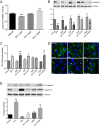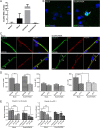Antiretroviral Treatment with Efavirenz Disrupts the Blood-Brain Barrier Integrity and Increases Stroke Severity
- PMID: 28008980
- PMCID: PMC5180178
- DOI: 10.1038/srep39738
Antiretroviral Treatment with Efavirenz Disrupts the Blood-Brain Barrier Integrity and Increases Stroke Severity
Abstract
The introduction of antiretroviral drugs (ARVd) changed the prognosis of HIV infection from a deadly disease to a chronic disease. However, even with undetectable viral loads, patients still develop a wide range of pathologies, including cerebrovascular complications and stroke. It is hypothesized that toxic side effects of ARVd may contribute to these effects. To address this notion, we evaluated the impact of several non-nucleoside reverse transcriptase inhibitors (NNRTI; Efavirenz, Etravirine, Rilpivirine and Nevirapine) on the integrity of the blood-brain barrier, and their impact on severity of stroke. Among studied drugs, Efavirenz, but not other NNRTIs, altered claudin-5 expression, increased endothelial permeability, and disrupted the blood-brain barrier integrity. Importantly, Efavirenz exposure increased the severity of stroke in a model of middle cerebral artery occlusion in mice. Taken together, these results indicate that selected ARVd can exacerbate HIV-associated cerebrovascular pathology. Therefore, careful consideration should be taken when choosing an anti-retroviral therapy regimen.
Figures







Similar articles
-
Efavirenz Has the Highest Anti-Proliferative Effect of Non-Nucleoside Reverse Transcriptase Inhibitors against Pancreatic Cancer Cells.PLoS One. 2015 Jun 18;10(6):e0130277. doi: 10.1371/journal.pone.0130277. eCollection 2015. PLoS One. 2015. PMID: 26086472 Free PMC article.
-
Archived HIV-1 DNA resistance mutations to rilpivirine and etravirine in successfully treated HIV-1-infected individuals pre-exposed to efavirenz or nevirapine.J Antimicrob Chemother. 2015 Feb;70(2):562-5. doi: 10.1093/jac/dku395. Epub 2014 Oct 25. J Antimicrob Chemother. 2015. PMID: 25344807 Clinical Trial.
-
Predicted residual activity of rilpivirine in HIV-1 infected patients failing therapy including NNRTIs efavirenz or nevirapine.Clin Microbiol Infect. 2015 Jun;21(6):607.e1-8. doi: 10.1016/j.cmi.2015.02.011. Epub 2015 Feb 19. Clin Microbiol Infect. 2015. PMID: 25704446
-
[The use of the non-nucleoside reverse transcriptase inhibitors nevirapine and efavirenz in the treatment of patients with a chronic HIV-I infection].Ned Tijdschr Geneeskd. 2006 Aug 5;150(31):1719-22. Ned Tijdschr Geneeskd. 2006. PMID: 16924943 Review. Dutch.
-
Has the time come to abandon efavirenz for first-line antiretroviral therapy?J Antimicrob Chemother. 2014 Jul;69(7):1742-7. doi: 10.1093/jac/dku058. Epub 2014 Mar 5. J Antimicrob Chemother. 2014. PMID: 24603962 Review.
Cited by
-
The impact of substance abuse on HIV-mediated neuropathogenesis in the current ART era.Brain Res. 2019 Dec 1;1724:146426. doi: 10.1016/j.brainres.2019.146426. Epub 2019 Aug 29. Brain Res. 2019. PMID: 31473221 Free PMC article. Review.
-
Role of aging in Blood-Brain Barrier dysfunction and susceptibility to SARS-CoV-2 infection: impacts on neurological symptoms of COVID-19.Fluids Barriers CNS. 2022 Aug 18;19(1):63. doi: 10.1186/s12987-022-00357-5. Fluids Barriers CNS. 2022. PMID: 35982454 Free PMC article. Review.
-
Factors Associated with Periodontitis in Patients with and without HIV.Int J Dent. 2023 Apr 29;2023:9929835. doi: 10.1155/2023/9929835. eCollection 2023. Int J Dent. 2023. PMID: 37159593 Free PMC article.
-
Cognitive trajectories over 4 years among HIV-infected women with optimal viral suppression.Neurology. 2017 Oct 10;89(15):1594-1603. doi: 10.1212/WNL.0000000000004491. Epub 2017 Sep 13. Neurology. 2017. PMID: 28904086 Free PMC article.
-
Opioid antagonists as potential therapeutics for ischemic stroke.Prog Neurobiol. 2019 Nov;182:101679. doi: 10.1016/j.pneurobio.2019.101679. Epub 2019 Aug 6. Prog Neurobiol. 2019. PMID: 31398359 Free PMC article. Review.
References
Publication types
MeSH terms
Substances
Grants and funding
LinkOut - more resources
Full Text Sources
Other Literature Sources
Medical

